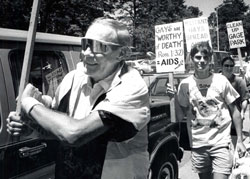A grand jury in Dallas County, Alabama, listened to testimony from Jacqueline Dixon, who had been held on a $100,000 bond awaiting the review after shooting her estranged husband in self-defense, on Oct. 11.
Dixon will no longer have to stand trial for the killing.
The shooting took place on July 31, outside of Dixon’s home in Selma, Alabama. “At the time of the shooting, she did feel like her life was in danger.
According to his report, Selma Police Chief Spencer Collier stated that police officers were dispatched around 8:30 a.m. and upon arrival; Carl Omar Dixon unresponsive in the front yard, and he was pronounced dead on the scene.
“In that type of situation, she should have a right to defend herself and defend her family,” Dixon’s attorney Richard Rice says in a statement to The Appeal, a criminal justice news outlet.
In 2016, Jacqueline requested an order of protection against Carl Omar, which was granted by a Dallas County judge. She also received full custody of the couple’s two children. According to court records, Jacqueline requested the order after Omar punched her in the face multiple times and swore at her repeatedly.
Since 2006, Alabama has had a “stand your ground” law in place.
Under state law, while a person can’t use deadly force if he himself is the aggressor, he no longer has to a “duty to retreat” if the other person is: About to use unlawful deadly physical force; A burglar about to use physical force; Engaged in kidnapping, assault, robbery, or rape; Unlawfully and forcefully entering a home or car, or attempting to remove a person against their will; Breaking into a nuclear power plant.
The Urban Institute found that in “stand your ground” states, when white shooters kill black people, 34 percent of the resulting homicides are deemed justifiable.
Only three percent of deaths are ruled justifiable when the shooter is black and the victim is white.
Even when black shooters kill black people, those shootings are less likely to be deemed justifiable in a court of law than those involving white shooters who kill white people.”
“Unfortunately, it’s no surprise to me that when black and brown people, and particularly black and brown women, use violence to defend themselves against attacks from men, whether it’s in intimate partner abuse or defending against police brutality or against white vigilantes taking matters into their hands, those same protections for gun ownership are not afforded to them in the same ways. I’m not surprised by the double standard at all,” said Johanna Foster, Ph.D., an associate professor of sociology.
She continued, and said, “One of the things that we do know is that women of color in the United States are often caught in a bind in that, historically and still today, they are unable to go to the state for the same kind of protections that many white women can seek, and then are blamed by the state for having to defend themselves.”
Foster explained that when women of color seek protection or redress, patterns where women of color have either been ignored by law enforcement, where police have minimized their reports, or law enforcement has wrongfully considered them perpetrators when they are actually seeking assistance for victimization.
Many proponents of arming the populace, including conceal and carry, ignore the potential for women to be armed to shoot and potentially kill men who attack them, physically and sexually,” said Katherine Parkin, Ph.D., a professor of history and gender studies.
“Men depend on controlling both the courts/laws that would deny women the ability to Stand Their Ground, as well as controlling the narrative that suggests that women are liars and that they should try to “care” for volatile men,” she said.
Parkin pointed that this gendered argument was advanced after the Parkland shooting, blaming the victims by asserting that the female students should have been nicer to the killer, even though he had abused those who had, in fact, been kind to him.
“As someone who studies gender theory and who studies the intersections of race, class, genders and sexualities, and how they play out particularly in the criminal justice system, it doesn’t surprise how the case is shaping out how it is,” said Foster.
She accredited much of her research to Kimberle Crenshaw, who first introduced the idea of intersectionality to feminism in the 1980s in order to address women of color.
She and her colleagues at the African-American policy forum recently released a report called Say Her Name which looks at the experiences of women of color who are victims of crime and what happens when they report crime, particularly women who are experiencing gender violence in the home or in their neighborhood.
“The research does show this appalling pattern of women of color who, when they call for help, are often blamed for the crime committed against them. Scholars have also documented cases of sexual violence that women of color have experienced while in police custody,” she said.
Dixon’s story is just one of many that confront the issues of class, race, and gender in the criminal justice system.
“The need to look at these cases through the lens of racism, sexism, and classism simultaneously is extremely important, but there is no question that women of color face that intersection of racism and sexism in their experiences throughout the legal system,” said Foster.
There is a pattern of unarmed women of color and girls being killed by police, Foster notes. “We hear a lot, as we should, of unarmed African-American and Latino men and boys being shot by police, but women and girls of color are often left out of the story,” she said.
Foster said that police brutality tends to be thought of as a crisis only affecting men and boys, “when in fact the data in this report show that women of color, particularly African-American and Latina women, are also at enormous risk of harm by law enforcement, either before custody or while in custody,” she concluded.




